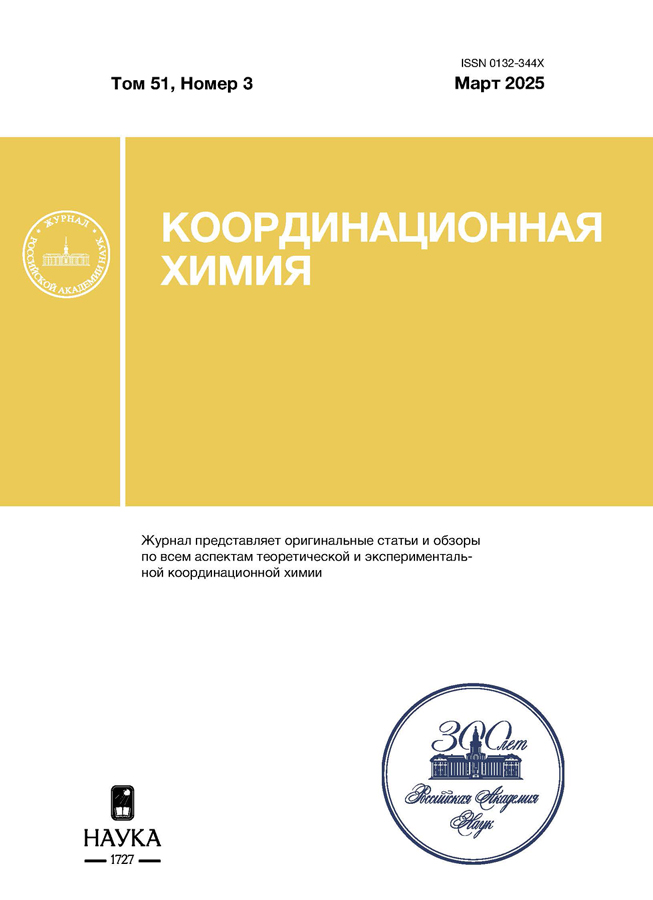Vol 51, No 3 (2025)
Articles
Peculiarities of the synthesis and structures of heterometallic carboxylate complexes with {Zn2Ln} and {Zn2Ca} metal cores
Abstract
The results of investigation of the heterometallic trinuclear {Zn2Ln} and {Zn2Ca} carboxylate coordination compounds are systematized in the review. The methods of the synthesis, structural peculiarities, and some physicochemical properties are discussed.
 145-164
145-164


Donor–acceptor chromophores based on coordination polymers of silicon(IV) and germanium(IV)
Abstract
New charge-transfer complexes with pyrazine are synthesized from germanium(IV) and silicon(IV) bis(catecholates): 36Сat2Ge, 35Cat2Ge, and 36Сat2Si (36Сat and 35Cat are 3,6- and 3,5-di-tert-butylpyrocatechol dianions, respectively). The synthesized compounds in the crystalline state are 1D coordination polymers with the octahedral environment of the complexing agent. The electronic absorption spectra of suspensions of the crystalline compounds in Nujol demonstrate an absorption in a range of 450–800 nm causing their intense color. A set of the spectral and theoretical studies indicates that the synthesized metal-organic frameworks of silicon and germanium can be considered as donor–acceptor chromophores with the photoinduced interligand charge transfer between the donor catecholate and acceptor pyrazine ligands.
 165-175
165-175


Fulvene complex stabilized by triangular ruthenium cluster
Abstract
The tetranuclear complex H2Ru4(CO)11(µ4-η1,η5-СС5H4) (I) was obtained by the photochemical reaction of Ru3(CO)12 with Z-1-(4-tolyl)-3-phenylaminoprop-2-en-1-one (λ ≥ 210 nm). The structure of complex I was established by single crystal X-ray diffraction. According to X-ray diffraction data, the complex is described by a superposition of resonance structures, that is, the carbene cluster YCRu3, in which the substituent Y at the carbyne carbon atom is (η5-C5H4)Ru(CO)2, and a vinylidene complex containing a fulvene form of the ligand, in which the exocyclic carbenium carbon atom is additionally stabilized by coordination to a triangular ruthenium cluster. For description of the interatomic binding in I, quantum chemical calculations of the electronic structure of the molecule in the gas phase were carried out at the PBE0/def2TZVP level. The features of binding of the organic ligand to the metal core were described in terms of the atoms in molecules theory. According to the calculations, the C6H4 moiety in I is a fulvene type ligand in which two hydrogen atoms in the CH2 group have been replaced by ruthenium atoms.
 176-186
176-186


Coordination compounds of uranyl nitrate with several amide ligands
Abstract
Reactions of UO2(NO3)2 with an amide L (L = acetamide, N,N-dimethylacetamide, propanamide, valeramide, benzamide, N-methylurea) in aqueous media resulted in formation of 6 coordination compounds [UO2(L)2(NO3)2], their compositions and structures were determined by elemental analysis, IR-spectroscopy, RFA and X-ray diffraction. The molecular structure and assignment of absorption bands for the obtained compounds are confirmed by quantum-chemical calculations.
 187-198
187-198


Synthesis and structure of cadmium, copper, and nickel pivalate and pentafluorobenzoate complexes with 2-amino-1-methylbenzimidazole
Abstract
A series of copper(II), nickel(II), and cadmium(II) compounds with pivalate (Piv) or pentafluorobenzoate (Pfb) anions and 2-amino-1-methylbenzimidazole (L) molecules, [Cu2(Piv)4(L)2]·2MeCN (I), [Ni(Piv)2 (L)2][Ni(Piv)2(L)2(MeOH)] (II), and [Cd(Pfb)2(L)2] (III), were obtained. In the case of copper compounds, a binuclear complex with a Chinese lantern structure was formed, while nickel and cadmium salts gave mononuclear complexes. In all synthesized compounds, the 2-amino-1-methylbenzimidazole molecule is a monodentate ligand, being coordinated to the metal atom through the benzimidazole nitrogen atom. The compounds were characterized by X-ray diffraction, IR spectroscopy, and CHN analysis.
 199-208
199-208












